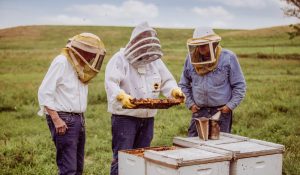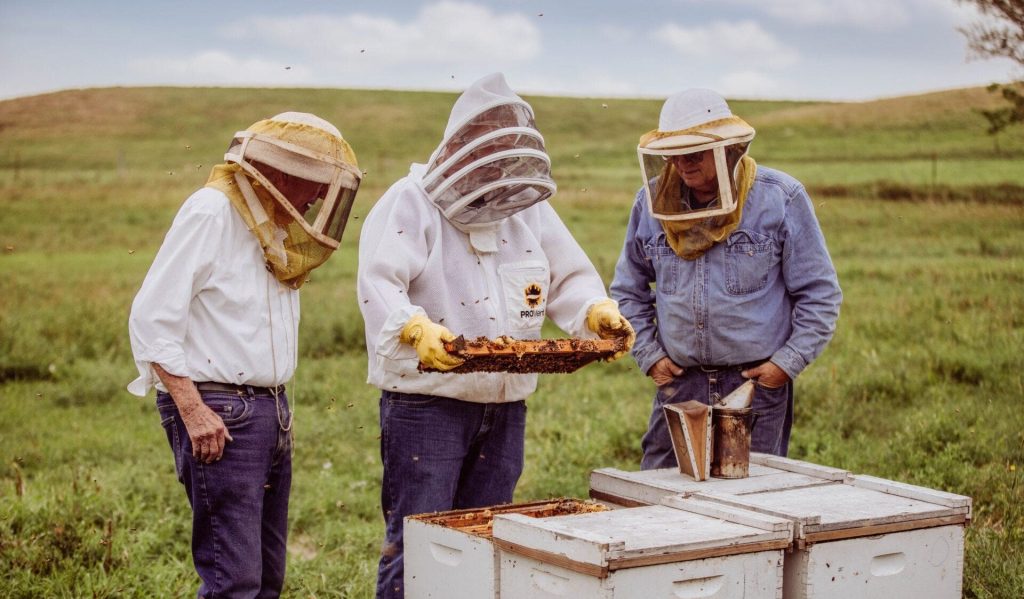
Honeybees pollinate $15 billion worth of crops in the United States each year
PIERRE, S.D. As temperatures warm, trucks loaded with bees travel across South Dakota as the insects head to their summer homes.
Beekeepers place the boxes filled with bees and honey supers in shelter belts, along creeks and in pastures. Enticed by blooms from lilac bushes, alfalfa, plum trees and dandelions, the tiny livestock head out in the cool mornings to gather nectar to make honey and transfer pollen.
In no other industry would the massive die-off of 40 percent to 70 percent of animals receive so little attention. Scientists estimate that approximately 80 percent of all flowering plants on Earth rely on pollinators like bees for reproduction. Without bees, many plant species would struggle to survive, leading to a significant decline in biodiversity.
Bret Adee of Adee Honey Farms, which processes honey in Bruce and Roscoe, said the bee die-off last winter has hit his industry hard.
“We had at least 70 percent of our bees die and we’re not sure why. It’s a real challenge across the entire country, from New York to Florida to California. It doesn’t matter whether hives were in mountains, near cities or on flat, open plains. Some losses have been as high as 95 percent and some as low as 40 percent.”
Beekeeping is considered farming by the IRS, and the federal government classifies honeybees as livestock.
According to a news release from Project Apis m., the Honey Bee Health Coalition, the American Beekeeping Federation and the American Honey Producers Association, about 1.6 million colonies in the U.S. died during the winter months. That’s a deeply concerning number considering there are typically about 3 million bee colonies in the U.S. The losses include about 62 percent of the colonies of commercial beekeepers, 54 percent of “sideliner” or mid-sized operations’ colonies and 51 percent of hobbyist beekeepers’ colonies.
Environmental problems could be cause of bee die-off
Adee believes environmental issues could be the root of the problem.
“Sometimes they approve products for human health without investigating the impact on beneficial insects,” he said. “Some blame neonicotinoids used in insecticides for crop protection, but I’m not sure that’s the problem. Others speculate that the Varroa mite has developed resistance to the efforts we take to protect hives.”
Researchers took samples from hives to the Agricultural Research Service in Maryland to determine the cause of the die-off. Adee believes the shake ups in government administration have delayed critical research needed to determine the cause of the bee deaths. Is it a new virus, a result of spraying or mites? Those are questions that need to be answered.
In the meantime, commercial bee operations such as Adee Honey try to provide supplemental proteins to their bees to strengthen them and improve their resistance. They provide trace elements and amino acids to their bees.
Adee estimated the business would finish placing hives with bees by Sunday, June 1. Temperatures in the 40s and 50s are ideal to move the hives as the bees stay in their boxes until about its around 55.
“In 2023, we had beautiful bees with great numbers, around 80,000 plus beautiful bee hives,” Adee said. “Because of this winter’s train wreck we were only able to restock about 70 percent of the beehives. I wish we had the answer to know what changed. Management stayed the same.”
This summer, the Adees will deliver fewer bees to the yards. Instead of 90 boxes, there might be 52; instead of 72 boxes, there might be 48.
In 2007, the industry faced colony collapse disorder. This is much worse, but based on past experience, Adee is hopeful.
“When we’ve had problems in the past, we know we can breed our numbers back to full from 60 percent,” he said. “That is the magic number. We don’t know if we can get back to full force starting from a loss of 70 percent. We breed back our survivor stock and hope that works.”
Queen bee concerns
Adee said it’s sad what has happened to queen bees. The queen is the heart of the hive. Historically, the queens live about five years with three very productive years. Now, they live only six months.
The Adees are dedicated to the honey business. Bret and his siblings Kelvin Adee and Marla Hoyer are the owners of the business. Their grandfather Vernon Adee started raising bees in 1934. Their dad Richard and his brother Stanley bought their first beekeeping operation in 1957 in South Dakota. They process honey in Bruce and Roscoe. Stanley was killed in a bee truck accident in 1959. The Adees position hives throughout South Dakota and southeastern North Dakota.
Crops have changed through the years with a lot fewer acres of alfalfa and rough pastures full of native flowering plants. Adee hopes the next Farm Bill will provide for more conservation acres, which include alfalfa and clover.
Field crops benefit from honeybees, with some studies showing a 20 percent yield increase when bees are in the area. The same is true for crops such as sunflowers, canola and buckwheat. While there aren’t huge numbers of acres in gardens and backyards, increasing plants for pollinators is always welcome.
Another enormous challenge is importing so-called honey from places like China and Vietnam.
“They are selling honey at the price of sugar; it’s not honey. I believe it’s a blatant fraud,” Adee said. “Our industry has gone from selling 200 to 225 million pounds of honey 40 years ago to 135 million pounds last year. Beekeepers can’t afford to produce or sell their honey at false prices. And consumers don’t get the health benefits provided by real honey.”
Even so, he remains upbeat.
“I admit I felt depressed in the winter. We really want to build back our hives so we can continue in this business that produces great honey. This summer, there will be fewer bees out there. But there will be bees, and we’ll do the best we can to care for them,” Adee said.
South Dakota honey numbers
Honey production in 2024 from South Dakota producers with five or more colonies totaled 13.3 million pounds, down 27 percent from 2023, according to the U.S. Department of Agricultures’s National Agricultural Statistics Service. South Dakota ranked third in the nation for honey production.
There were 250,000 honey producing colonies in South Dakota during 2024, up 19 percent from 2023. The average yield was 53 pounds per colony, down 34 pounds from 2023. Producer stocks were 8.75 million pounds on Dec. 15, 2024, down from 12.4 million pounds a year earlier.
Prices for the 2024 crop averaged $1.84 per pound, down from $1.95 per pound in 2023. Prices were based on retail sales by producers and sales to private processors and cooperatives. The total value of honey produced in South Dakota last year was $24.5 million.


